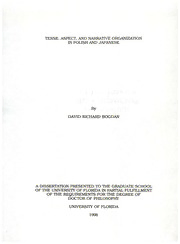
Tense, aspect, and narrative organization in Polish and Japanese PDF
Preview Tense, aspect, and narrative organization in Polish and Japanese
TENSE,ASPECT,ANDNARRATIVEORGANIZATION INPOLISHANDJAPANESE By DAVIDRICHARDBOGDAN ADISSERTATIONPRESENTEDTOTHEGRADUATESCHOOL OFTHEUNIVERSITYOFFLORIDAINPARTIALFULFILLMENT OFTHEREQUIREMENTSFORTHEDEGREEOF DOCTOROFPHILOSOPHY UNIVERSITYOFFLORIDA 1998 Copyright1998 by DavidRichardBogdan ACKNOWLEDGMENTS IcouldnothaveattemptedthisstudynorwouldIevenbein the field oflinguistics were it not for the chair ofmy committee, Dr. WilliamJ. Sullivan. Hesparkedmyinterestinlinguisticover20years ago when I was still an undergraduate majoring in physics. He has guidedme throughmymaster’s andmydoctorateall along, goingwell beyondwhatwould be expected oforhoped forfrom an advisor. The original suggestion for a tripartite discourse structure reflected in tense/aspect choices emerged from his work in teaching Russian composition. Doingmydissertationfromhalfwayaroundtheworldhas putextremepressureonhim,andIapologizeforthis,while, atthesame time,thankinghimforallhishelp. Ialsowanttoexpressmyappreciationtotheothermembers ofmycommittee,ProfessorsJeanCasagrande,ChaunceyC.Chu,AnnK. Wehmeyer, and Douglas D. Dankel, who have all provided valuable insightandassistanceallthroughoutmyextendedgraduatecareer. iii I am deeply indebted to Dr. Danuta Romanowska at Uniwersytetim. AdamaMickiewiczainPoznan, Poland. Correctingmy error-riddene-mailversion, shecarriedoutthePolishsurveyforme in herclasses, andsentallthematerialsbacktome. Asthe surveywas essentialtothisstudy,Icannotsufficientlyexpressmygratitude. My appreciation also goes to Dr. Alfred Majewicz (also at UAM) for sending a copy of his book, to Dr. Shoichi Iwasaki for responding to my e-mail questions pertaining to his dissertation and book,toSawakoAgawaforpermittingmetouseaportionofheressayas the surveymaterial forJapanese, and to Mr. Yoshihiro Sugita ofALC PressforhelpingmecontactMs.Agawa. IneedtothankmyfamilyintheUSforhavingsupportedmy effortsforsomanyyearsandfortheirbeliefinme. Myfamilyhere in Japan (including my in-laws) has also been very supportive. I must apologizetoandthankmytwoyoungchildren,whohavenothadawhole lot ofaccess to their father in recent months, and mywife, who has helped me in my attempts to isolate myself in order to write this dissertation. Shehasalsoprovidedmanyveiyhelpfulinsightsintothe Japanesedata. iv TABLEOFCONTENTS ACKNOWLEDGMENTS iii ABBREVIATIONS ix ABSTRACT x INTRODUCTION 1 11..21 PNarrerlaitmiivnearaynRdeNmaarrrkatsiveStructure 11 1.3 ContentoftheStudy 4 1.4 Notes 5 TENSEANDASPECTINPOLISH 6 2.1 Introduction 6 2.2 BasicConcepts 6 2.2.1 Tense 6 2.2.2 Aspect 8 2.2.3 Perfective/ImperfectiveDivision 9 2.2.4 Aktionsart 10 2.3 ThePolishTense-AspectSystem 11 2.4 AspectinPolish 12 2.5 DiscourseApproachestoAspect 16 2.5.1 DiscourseFunction 16 2.5.2 RhetoricalFunctions 17 2.5.3 ThreeNarrativeFunctions 18 2.5.4 ATestofAspectUseinRussian 21 2.6 Terminology 24 2.7 ThePolishAnalysis 25 2.8 Notes 26 TENSEANDASPECTINJAPANESE 28 3.1 Introduction 28 3.2 SogaonTenseandAspect 29 3.2.1 JapaneseTenseMorphology 29 3.2.2 Aspect 31 3.2.3 VerbClassificationinJapanese 32 3.2.4 SogaandNarrativeStructure 34 3.3 Szatrowski'sApproach 36 3.3.1 Introduction 36 3.3.2 Approach 37 3.3.3 FeaturesTested 37 3.3.4 Methodology 38 v 1 3.3.5 ResultsforIndividualFeatures 40 Pastness 41 NarrativeEvent 42 Continuity 44 SpeakerA'sExperience 45 Vividness 45 Generality 48 Characterization 48 Evaluation 49 Emotionality 49 Explanation 50 Description 50 3.3.6 SummaryofResults 51 3.4 Iwasaki'sApproach 54 3.4.1 Introduction 54 3.4.2 TypesofSubjectivity 55 3.4.3 Functionsofthe-taand-ruForms 57 Temporalandnon-temporaluseof-taand-ru 57 Temporalusewithinthenarrative 58 3.4.4 TheData 60 Texttypes 60 Clausesinvestigated 61 3.4.5 InformationAccessibility,TransitivityandSpeaker's Perspective 63 3.4.6 Results 66 -ruinfirst-personclauses 66 -tainnon-first-personclauses 67 Hiddenexperiencer 68 Discovery 70 3.5 VividnessRevisited 72 3.6 Notes 73 ANALYSISOFTHECAMPINGSTORY 76 4. PreliminaryRemarks 76 4.1.1 FactorsInfluencingTense 77 4.1.2 FactorsInfluencingAspectChoice 81 4.2 TheData 82 4.2.1 SurveyMethodology 83 4.2.2 OrganizationofResults 86 4.2.3 ExplanationofAppendicesP-3,P-4,P-5,andP-6 88 4.2.4 TheNumbers 90 4.2.5 The90%/10%Cut-off ’ 92 4.3 OverallStatisticalResults 93 4.3.1 Speaker’sAspectChoice 93 4.3.2 Speaker'sTenseChoice 95 4.3.3 Respondents'AspectChoice 96 4.3.4 Respondents'TenseChoice 97 vi 4.4 DetailedAnalysis 99 4.4.1 Preliminaries 99 4.4.2 GeneralObservations 99 4.4.3 TenseSequencinginPolish 100 4.4.4 InteractionoftheInfluencesontheData 101 4.4.5 SubordinationandTenseSelection 103 4.4.6 NegationandAspectVariation 113 4.5 FunctionalApproach 116 4.5.1 PointofViewandSubstories 117 4.5.2 DiscourseFunctionsandNarrativeStructure 123 4.6 Notes 128 JAPANESEANALYSIS 130 5.1 Introduction 130 5.2 TheDataSurveyMethodology 130 5.3 Results 132 5.3.1 Appendices 132 5.3.2 OverallNumbers 133 5.3.3 IndividualChoices 135 5.3.4 T/AFormsandDiscourseFunction 135 5.3.5 Clause-by-ClauseAnalysis 139 (1)dekita'hadopenedup' 139 (2)ittemita'went' 140 (3)aru'weren't' 140 (4)sageta'lowered' 141 (5)tateteiru'gave' 142 (6)hohoenda'smiled' 143 (7)atta'looked' (8)ii'wasnice' (9)datta'was' 143 (10)aru'seemed' 145 (11)hiraku'opened' 145 (12)yattekita'came' 146 (13)aru'was'(14)hohoende-wa-iru'wassmiling' . . . 146 (15)satteitta'left' 147 (16)motteita'wascarrying' 147 (17)wakaranai'don'tknow' (18)rashii'lookslike' .. 148 (19)aru'was'(20)makushitateru'rattledoff 148 (21)totteita'weretaking' 149 5.4 Comments 149 5.5 Notes 150 CONCLUDINGREMARKS 152 6.1 DiscourseFunctionandNarrativeStructure 152 6.2 Context-sensitiveMarkedness 154 6.3 Substories,PointofView,andNarrativeStructure 156 6.4 BackgroundandSubordination 157 6.5 ConcernsabouttheDataandMethodology 159 6.6 FinalComments 160 vii TRANSCRIPTOF CAMPINGSTORY 162 TRANSLATIONOFCAMPTEXT 166 COMBINEDRESULTS 170 RESULTSFORSPEAKER 176 T&AGroup 176 TGroup 179 AGroup 180 RESULTSFORRESPONDENTS(90%ANDOVER) 182 T&AGroup 182 TGroup 184 AGroup 185 SLOTSWITHHIGHVARIATION 186 T&AGroup 186 TGroup 187 AGroup 187 NARRATIVEFUNCTIONANDPOINTOFVIEW 188 BREAKDOWNOFDISCOURSEFUNCTION 195 Plot 195 Description 197 Flashback 200 Interaction 200 JAPANESETEXT 202 TRANSLATIONOFJAPANESETEXT 204 COMBINEDRESULTS 206 WRITERSCHOICES 207 RESPONDENTS' CHOICES 208 NARRATIVEFUNCTIONANDPOINTOFVIEW 209 BIBLIOGRAPHY 210 BIOGRAPHICALSKETCH 217 viii ABBREVIATIONS SP = speaker'sperspective(Iwasaki) DF = discoursefunction(approach) t/a = tense-aspect P = perfective i = imperfective np = non-pastperfective ni = non-pastimperfective PP = pastperfective, Pi = pastimperfective. np-perf = non-pastperfective np-imp = non-pastimperfective p-perf = pastperfective, p-imp = pastimperfective. P? — past(aspectundetermined) <mod> = modal <fi> = future(disjoint)imperfective <c> = command <part> = participle ix AbstractofDissertationPresentedtotheGraduateSchool oftheUniversityofFloridainPartialFulfillmentofthe RequirementsfortheDegreeofDoctorofPhilosophy TENSE,ASPECT,ANDNARRATIVEORGANIZATION INPOLISHANDJAPANESE By DavidRichardBogdan May, 1998 Chairperson:WilliamJ.SullivanIII MajorDepartment:PrograminLinguistics This studyisconcernedwiththe relationshipbetweennarrative structure and the use of tense-aspect forms. Two quite different languages,PolishandJapanese,areinvestigatedandcompared. There is morphological/syntactic/semiological (distributional) evidence for three types oftext function in narrative structure: plot, description,andbackground. Plot clauses advance the plot line of a narrative and are the backbone of the story. Description clauses provide supplementary materialaboutthesetting, describingthephysicallocus oftheaction, the physical condition ofthe participants, their states ofmind, etc. Clausesofthethirdtype, background, representeventsand situations x
